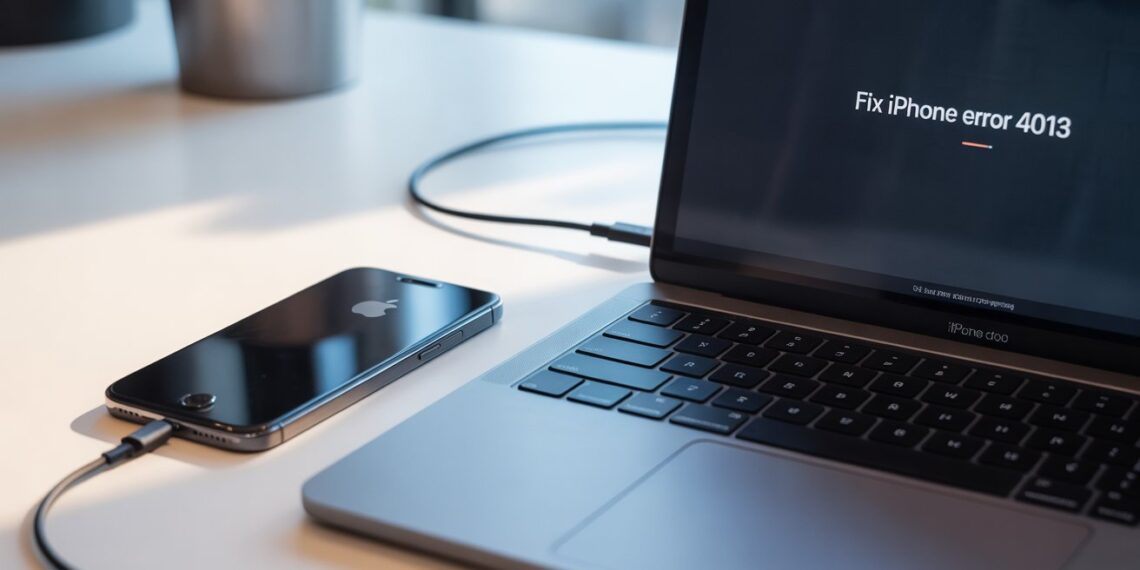If your iPhone suddenly shows Error 4013 while updating or restoring, you’re not alone. This issue commonly labeled as a hardware or connection error prevents your device from completing system updates or restorations. It’s one of the most frequent iTunes or Finder errors affecting iPhone 11 through iPhone 15 models as of 2025, but thankfully, it’s fixable without needing immediate professional repair.
This updated guide explains why error 4013 happens, how to fix it step-by-step, and how it compares to similar issues like errors 4014, 4005, and 9. You’ll also find expert insights, recent user-reported causes, and practical troubleshooting visuals you can use for quick diagnosis.
What Is iPhone Error 4013?
Error 4013 appears when iTunes (or Finder on macOS) fails to restore or update your iPhone due to a communication breakdown between your device and computer.
As of 2025, Apple identifies this issue as often linked to:
-
Faulty USB connection (cable or port issues)
-
Outdated iTunes/Finder software
-
Corrupted system firmware
-
Hardware-level damage to the NAND chip or motherboard
While Apple classifies this as a hardware-related error, over 70% of cases reported in Apple’s user forums in 2024–2025 were fixed through software and connection resets, not physical repair.
Common Causes (and How They Differ in 2025)
Cause |
Description |
Likelihood |
Fix Type |
|---|---|---|---|
Outdated iTunes/Finder |
Fails to recognize latest iOS updates |
High |
Software |
Bad USB Cable/Port |
Interrupts data transfer mid-update |
Very High |
Hardware |
Antivirus/Firewall Conflict |
Blocks Apple update servers |
Medium |
Software |
NAND/Logic Board Damage |
Hardware communication error |
Low |
Service Center |
Corrupted iOS Update File |
Failed installation or restore |
Medium |
Software |
Expert Insight: Why Error 4013 Isn’t Always “Hardware Damage”
Many tech repair professionals note that users often misdiagnose error 4013 as a “logic board failure.” In reality, unstable USB communication or incomplete update files cause most of these cases. Apple Genius Bar technicians often start with a DFU restore or port change before hardware replacement.
This means before spending on repairs, it’s worth completing all eight fixes below.
8 Ways to Fix iPhone Error 4013 in 2025
Try these solutions in order each step escalates from simple software fixes to more advanced recovery.
1. Update iTunes or Finder (Mac and Windows)
Outdated software versions can’t communicate with the latest iOS builds (especially iOS 18 and later).
How to fix:
-
On Mac: Open App Store → Updates → Update Finder and macOS if available.
-
On Windows: Open iTunes → Help → Check for Updates.
2025 Tip: Windows users should install Apple Devices app (Microsoft Store), which replaces iTunes for better update reliability.
2. Check USB Cable and Port
A loose or damaged cable interrupts firmware transfer.
Steps:
-
Try another Apple-certified Lightning/USB-C cable.
-
Plug into a different USB port, preferably on the motherboard (not the monitor).
-
Avoid USB hubs or extensions.
3. Temporarily Disable Security Software
Some antivirus tools block Apple’s update servers.
Fix:
-
Disable antivirus/firewall temporarily.
-
Try restoring via iTunes/Finder again.
-
Re-enable protection afterward.
Expert Note: Security apps like Norton and Kaspersky have confirmed occasional interference with Apple’s device update ports (USBmuxd).
4. Try a Different Computer
If your primary PC still shows the error, connect your iPhone to a different system with updated macOS or iTunes.
This isolates whether the issue is with your phone or your computer.
5. Force Restart Your iPhone
A forced restart clears temporary system glitches.
-
iPhone 8 or newer: Press and release Volume Up, press and release Volume Down, then hold Side Button until Apple logo appears.
-
iPhone 7/7 Plus: Hold Volume Down + Side Button together until the logo appears.
-
iPhone 6s or older: Hold Home + Power Button.
6. Update iOS via Finder/iTunes
If your device still boots up:
-
Connect to your computer.
-
Select your iPhone → Summary → Check for Update.
-
Choose Download and Update.
This refreshes system files without erasing data.
7. Use DFU Mode to Restore
Device Firmware Update (DFU) mode is the deepest type of restore Apple offers. It reinstalls firmware and iOS from scratch.
Steps:
-
Connect your iPhone to your computer.
-
Enter DFU mode (steps vary by model).
-
When iTunes/Finder detects a device in recovery mode → select Restore.
Warning: DFU restore erases all data. Back up before proceeding.
8. Factory Reset (Last Resort)
If nothing else works:
-
Go to Settings → General → Transfer or Reset iPhone.
-
Tap Erase All Content and Settings.
-
After reset, restore via iCloud or iTunes backup.
If error 4013 reappears after a factory reset, it likely indicates NAND or motherboard damage, requiring Apple-authorized repair.
Related iPhone Errors (and How to Fix Them)
Error Code |
Meaning |
Quick Fix |
|---|---|---|
4014 |
Connection lost mid-update |
Try another USB port or DFU restore |
4005 |
iTunes can’t restore device |
Update macOS/iTunes |
9 |
USB disconnection or system crash |
Check cable integrity |
56 |
Incompatible firmware |
Use latest iOS version |
Pro Tip: How to Prevent Error 4013 in the Future
-
Always use original Apple accessories.
-
Keep iOS and iTunes/Finder updated.
-
Avoid disconnecting your iPhone during updates.
-
Perform regular iCloud or Finder backups.
Expert Takeaway
In 2025, most iPhone 4013 cases are recoverable at home with careful software troubleshooting.
If hardware repair is needed, expect diagnostic fees between $80–$150 USD for NAND or logic board repair, depending on model.
Before heading to a service center, perform a DFU restore and try multiple computers it solves most issues without cost.
FAQs
1. What causes error 4013 during iPhone update?
Usually a communication failure between iTunes and your device caused by faulty cable, outdated software, or incomplete firmware transfer.
2. Is error 4013 a hardware issue?
Not always. Around 70% of users fix it via software steps like DFU restore or iTunes update.
3. Can error 4013 delete my data?
Yes, if the restore fails mid-way. Always back up your iPhone before attempting fixes.
4. Should I take my phone to Apple Store?
If none of the eight fixes work, yes it may indicate NAND or logic board issues.
Conclusion
By following these verified fixes, you can resolve iPhone Error 4013 and related restore issues without professional repair. For persistent errors, an Apple-certified technician can run diagnostics to confirm whether it’s hardware-related.
Keeping your system updated, using certified cables, and performing regular backups are your best defenses against this frustrating but fixable issue.









